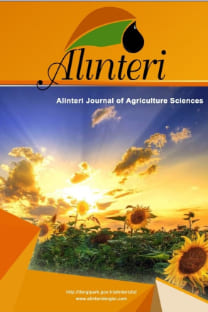Alternatif Yakıt Kaynağı Olarak Biyoetanol
Biyoetanol, biyokütle, yenilenebilir enerji
-
Bioethanol, biomass, renewable energy,
___
- Adigüzel, A., O., 2011. Lignoselülozik Biyokütleden Biyoetanol Üretimi, Mersin Üniversitesi, Fen Bilimleri Enstitüsü, Biyoloji Ana Bilim Dalı, Yüksek Lisans Semineri, 72 s.
- Aggarwal, N.K., Nigam, P., Singh, D., Yadav, B.S., 2001. Process optimization for the production of sugar for the bioethanol industry from sorghum, a non-conventional source of starch. World Journal of Microbiology & Biotechnology, 17: 411-415.
- Almodares, A. and Hadi, M.R., 2009. Production of bioethanol from sweet sorghum: A review. Afri-can Journal of Agricultural Research, 4 (9): 772 - 780.
- Anonim, 2012. Batı Akdeniz Kalkınma Ajansı, Biyokütle Sektör Raporu. 13 s. Erişim: 26.11.2013, http://www.baka.org.tr/uploads/1349952570BiYOKUTLE-SEKTOR-RAPORU-11EYLUL.pdf
- Anonim, 2013. Enerji Piyasası Düzenleme Kurumu, Petrol Piyasası Sektör Raporu (2012). http://www.epdk.gov.tr//documents/petrol/rapor_yayin/Ppd_Rapor_Yayin_Sektor_Raporu_2012.pdf, Erişim: 25.10.2013
- Anonim, 2014A. http://www.eie.gov.tr/yenilenebilir/biyoetanol.aspx Erişim:07.08.2014
- Anonim, 2014B. H., TOSUN, http://www2.bayar.edu.tr/muhendislik/gida/docs/databank/unite9.pdf Erişim: 08.07.2014.
- Anonim, 2014C.http://www.earth-policy.org/datacenter/pdf/book_wote_energy_biofuels.pdf Eri-şim:08.08.2014
- Anonim, 2014D. http://ethanolrfa.org/pages/World-Fuel-EthanolProduction Erişim:08.08.2014
- Anonim, 2014E. http://makinecim.com/bilgi_5357_Fermantasyon-ile-Biyoetanol-eldesi. Erişim Tarihi: 21.10.2014
- Balat, M., Balat, H., Öz, C., 2008. Progress in bioethanol processing. Progress in Energy and Com-bustion Science, 34: 551-573.
- Bayrakçı, A.G., 2009. Değişik biyokütle kaynaklarından biyoetanolün elde edilmesi üzerine bir araş-tırma. Ege Üniversitesi Fen Bilimleri Enstitüsü, Yüksek Lisans Tezi (Basılmamış), İzmir.
- Bulut, B. 2006. Tarıma dayalı alternatif yakıt kaynaklarından biyoetanol ve Türkiye için en uygun biyoetanol hammaddesi seçimi. Yıldız Teknik Üniversitesi, Fen Bilimleri Enstitüsü, Endüst-ri Mühendisliği Anabilim Dalı. Yüksek lisans tezi. 122 s.
- Demirbaş, A., 2005. Bioethanol from cellulosic materials: a renewable motor fuel from biomass. Energy Sources Part A 2005;27:327–37.
- Demirbaş, A., 2007. Progress and recent trends in biofuels. Progres in Energy and Combustion Scien-ce, 33: 1-18.
- Demirbaş, A., 2008. Biofuels sources, biofuel policy, biofuel economy and global biofuel projections. Energy Conversion and Management, 49: 2106-2116.
- Demirbaş, A., 2009. Biofuels securing the planet’s future energy needs. Energy Conversion and Management, 50: 2239-2249.
- Gross, R., Leach, M., Bauen, A., 2003. Progress in renewable energy. Environment International, 29: 105-122.
- Johnston J. New world for biofuels. Energy Law 2008;86:10e4.
- Melikoğlu, M., Albostan, A., 2011. Türkiye’de biyoetanol üretimi ve potansiyeli. Gazi Üniversitesi Mühendislik ve Mimarlık Fakültesi Dergisi, 26 (1) : 151-160.
- Meral, R., Saydan Kanberoğlu, G., 2012. Tahıllardan etanol üretimi. Iğdır Üniversitesi Fen Bilimleri Dergisi, 2(3):61-68.
- Nıgam, R.B., and P.K. Agrawal. 2004. “Ethanol Manufacturer from Cane Juice and Molasses: A Diversification for Sugar Industry in India”. Proceedings of the international conference on Biofuels: Perspective & Prospects, Winrock International, India. 16-17, September.
- Nigam, S.P and Singh, A. 2010. Production of liquid biofuels from renewable resources. Progress in Energy and Combustion Science 37 (2011) 52e68.
- Prasad, S., Singh, A., Joshi, H.C., Ethanol as an alternative fuel from agricultural, industrial and urban residues. Resour. Conserv. Recy., 50, 1–39, 2007.
- Sabancı, A., Ören, M.N., Yaşar, B., Öztürk, H.H., Atal, M., 2010. Türkiye’de biyodizel ve biyoetanol üretiminin tarım sektörü açısından değerlendirilmesi. Ziraat Mühendisleri Odası 7. Teknik Kongresi, Ankara. 2:933-953.
- Shafiee, S., Topal, E., 2009. When will fossil fuel reserves be diminished?,. Energy Policy, 37:181-189.
- Sıngh D, Dahiya JS, Nıgam P. Simultaneous raw starch hydrolysis and ethanol fermentation by glu-coamylase from Rhizoctonia solani and Saccharomyces cerevisiae. J Basic Microbiol 1995;35:117e21.
- Sluıter, J.B., Ruız, R.O., Scarlata, C.J., Sluıter, A.D., and Templeton, D.W., 2010. “Compositional Analysis Of Lignocellulosic Feedstocks. 1. Review And Description Of Methods, Journal of Agricultural and Food Chemistry. 58: 9043–9053.
- Smıth A.M. Prospects for increasing starch and sucrose yields for bioethanol production. Plant J 2008;54:546–58.
- Sun, Y., Cheng, J. 2002. Hydrolysis of lignosellulosic materials for ethanol production: A review. Bioresource Technology, 101:4744-4753.
- Turov, Y.Y., 1965. Petrochemical Production of Japan. Chemistry and Tecnology of Fuels and oils, 1: 160-164, 1965.
- Verma G, Nıgam P, Sıngh D, Chaudhary K. Bioconversion of starch to ethanol in a single step pro-cess by co-culture of amylolytic yeasts and Saccharomyces cerevisiae 21. Bioresour Tech-nol 2000;72:261e6.
- ISSN: 2564-7814
- Yayın Aralığı: 2
- Başlangıç: 2007
- Yayıncı: Adem Yavuz SÖNMEZ
Yayladağı Sulama Göleti (Hatay) Suyunun Bazı Fiziksel ve Kimyasal Özelliklerinin İncelenmesi
Şerafettin KELEŞ, Murat DİLMAÇ, Arzu TURAL DİKMEN
Soner BİLEN, Esra SOYDAŞ, Aslı BİLEN
Alternatif Yakıt Kaynağı Olarak Biyoetanol
Eskişehir İli Tarım İşletmelerinde Traktör Kullanımına İlişkin Masraf Unsurlarının Tespiti
